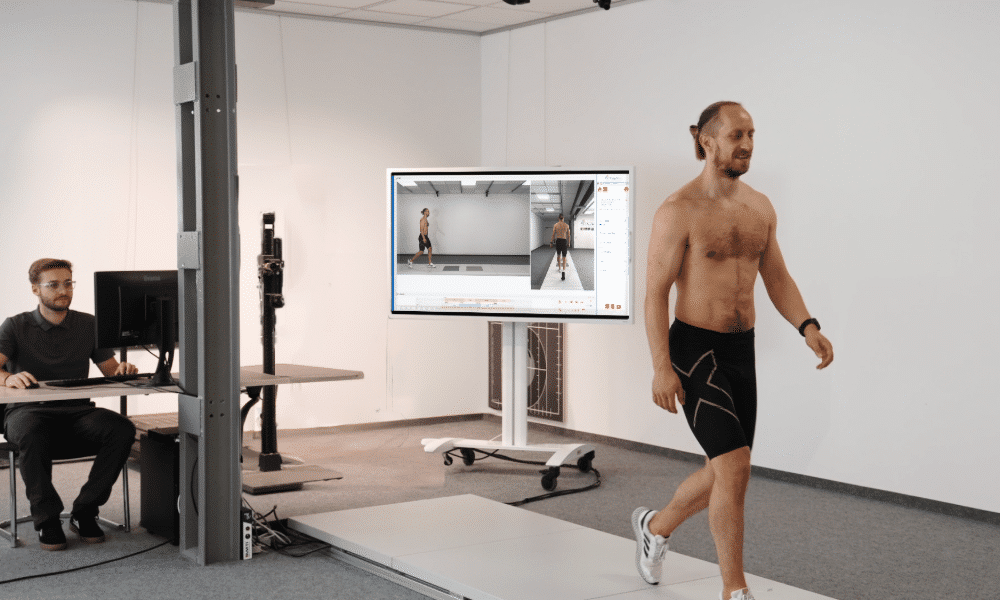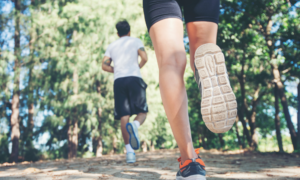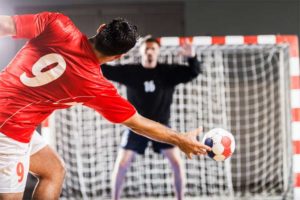The biomechanical aspects of dynamic Gait Analysis
When walking, the body is moved forward by a repetitive movement pattern of the extremities while simultaneously maintaining stability. This involves a complex interplay of balance and coordination of our musculoskeletal system and joints.
Walking is primarily divided into different phases of the gait cycle, including foot strike, roll-off, push-off and swing. A gait cycle corresponds to a double step. The two main phases of gait are known as the stance and swing phases. The stance phase describes the period from the initial contact of one foot with the ground until the same foot lifts off the ground. The swing phase, on the other hand, is the period in which the foot lifts off the ground and the forward movement begins. The stance phase usually takes up 60 % of the time of a double step, while the swing phase accounts for 40 % of the time of a double step. By analysing these phases in detail, it is possible to determine whether the gait movement pattern is normal or exhibits abnormalities.
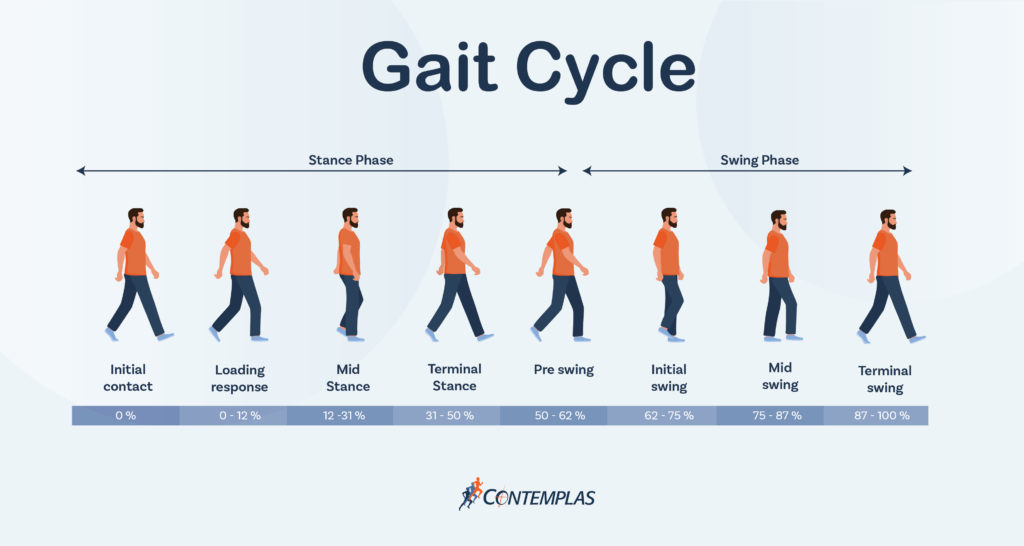
In Gait Analysis, a distinction is made between instrumental (objective) Gait Analysis and subjective (observational) Gait Analysis based on the analyst’s perception.
In objective Gait Analysis, the gait is examined through three primary measurements:
- Kinematics defines the range and timing of all joint movements, which play a crucial role in Gait Analysis. Each joint in the body has a specific range of motion and function. By examining joint movements during walking, potential problems such as stiffness, instability or restricted mobility can be identified.
- Kinetics deals with the forces acting on the body. Walking generates various forces that impact the joints, muscles and bones. By measuring these forces, it is possible to determine whether the body is exposed to excessive strain or if certain areas of the body are subject to increased stress. Force plates (e.g., from AMTI) or pressure plates (e.g., from Zebris) embedded in the walkway can be used to collect measurements.
- Dynamic electromyography (EMG) records the electrical activity of muscles during dynamic tasks. In Clinical Gait Analysis, it is essential to determine the timing and relative intensity of specific muscles or muscle groups. The use of surface electrodes (e.g. from COMETA) provides immediate feedback on muscle activity and provides specific information on the function of individual muscles during walking.
By analysing these aspects, a better understanding of movement patterns during walking can be gained and potential problems or deviations identified. However, this requires a basic understanding of the measurement ranges. In addition, a suitable system is required. For example, CONTEMPLAS Gait Analysis can be used to easily measure and analyse stride length, walking speed, stride frequency, joint angle, forces, pressure distribution and muscle activity.
In subjective Gait Analysis, the gait is assessed based on the observer's perception:
Subjective impressions and observations play an important role in identifying potential deviations in gait patterns. The analyst observes the patient’s movements, paying attention to symmetry, rhythm and any abnormalities in the gait pattern. This observation process can be simplified by using a predefined analysis framework. This subjective assessment can provide initial indications of potential problems or limitations in the gait pattern, which can then be examined in more detail as part of the objective Gait Analysis. The subjective Gait Analysis therefore complements the instrumental evaluation and enables a comprehensive assessment of the gait.
The importance of video-based Gait Analysis
Generally speaking, Gait Analysis is a diagnostic procedure that provides detailed insights into a person’s movement patterns, which then form the basis for targeted therapeutic or preventive measures. Video recordings play an essential role in the process of visualising and reproducing movement sequences during walking. By recording the gait with cameras, detailed information about the movements of the entire body (head, torso, arms and legs) can be obtained. Technological innovations make it possible to carry out both a qualitative analysis and a quantitative evaluation of the data. With video-based software (such as TEMPLO® by CONTEMPLAS), the data is recorded, processed, and graphically visualised. Movements can now be analysed frame by frame, meaning that every single step and movement can be examined in detail. As a result, potential deviations or anomalies can be detected that may not be visible to the naked eye. It is recommended to always record the gait from at least two perspectives: frontal and lateral. Video recording is at all times the foundation of a comprehensive Gait Analysis.
Where is video-based Gait Analysis applied?
Video-based gait analysis is utilised in various fields, such as sports medicine, rehabilitation, and medical supply stores. It enables the understanding of movement patterns, identification of issues, and the development of targeted treatment plans to enhance gait and prevent injuries.
Examples of applications in rehabilitation:
Gait Analysis has numerous applications in rehabilitation. It can help to identify movement deficits and develop targeted treatment plans.
- In neurological rehabilitation, Gait Analysis is often used to investigate gait disorders in patients with stroke, Parkinson’s disease or multiple sclerosis. By analysing gait patterns, potential problems can be identified and targeted therapies, such as gait training or the adjustment of walking aids, can be developed.
- Gait Analysis also plays an important role in orthopaedic rehabilitation. It can help to identify movement deficits after injuries or surgeries and develop targeted treatment plans. By analysing gait pattern, it is possible to determine whether the gait movement is normal or whether anomalies occur that require further treatment.
Example: Post-operative rehabilitation following knee or hip replacement involves using Gait Analysis to monitor the healing process and optimize load distribution on the operated joint. - Gait Analysis is also used in the development of prostheses and orthopaedic aids. By analysing the gait pattern of patients with amputations or other impairments, the functionality and fit of prostheses and aids can be improved.
Example: Gait Analysis enables the adaptation of orthopaedic footwear and insoles as well as prosthetic components to achieve symmetrical weight distribution and for a more natural gait. - In paediatric rehabilitation, Gait Analysis can be used to detect developmental disorders or congenital abnormalities at an early stage. Through continuous monitoring, targeted therapeutic measures can be developed to support motor development and improve mobility.
Example: The treatment of children with cerebral palsy involves using Gait Analysis to develop personalized treatment plans and assess the effectiveness of interventions and physiotherapy exercises.
Overall, Gait Analysis in rehabilitation can potentially improve the treatment process and optimise patient outcomes. Through the precise examination of the gait pattern, targeted therapies can be developed and progress tracked over time. This enables personalised and efficient therapy planning that is tailored to the individual needs of each patient.
"By using several cameras in combination with pressure distribution measurement and EMG, joint loads can be analysed and interpreted."
Orthopädisches Spial Speising
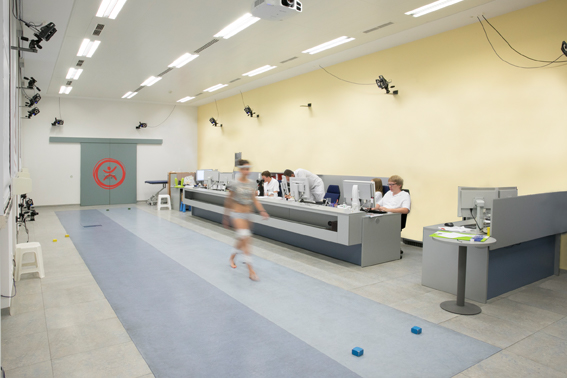
Technological advances in Gait Analysis
Gait analysis has advanced significantly in recent years, thanks to new technologies and methods. Overall, technological advances in Gait Analysis enable an even more accurate and comprehensive examination of gait patterns.
One of the most important developments is the use of markerless tracking during walking. By utilising algorithms and machine learning, movement patterns can be automatically recognised and analysed. This results in an objective and efficient analysis without the need for time-consuming and subjective application of markers.
The technical advancement of 3D motion analysis, such as Theia, has also impacted Gait Analysis. These systems capture movements in three dimensions, allowing for a detailed analysis of gait. It is recommended to use at least eight cameras to gain a comprehensive picture of the movement process during walking.
An encouraging trend is the increased integration of artificial intelligence and machine learning in Gait Analysis. By utilizing algorithms and neural networks, movement patterns can be automatically recognised, analysed, and interpreted. This leads to quicker and more efficient results, as well as the development of more precise treatment plans.
Stay informed about the latest technological developments! Subscribe to our newsletter now and never miss an important update.

